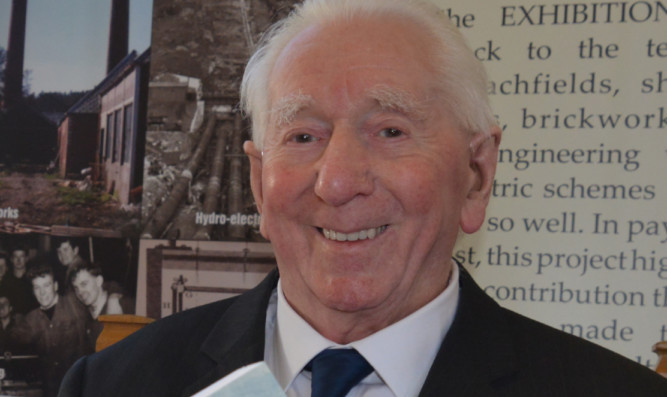For most of his 95 years, Arthur Nevay has lived at only two addresses remarkably just a few yards apart, in the west Fife former mining village of Glencraig.
Yet despite his down-to-earth nature, former internationally-renowned hairdresser Arthur is a cut above when it comes to his in-depth knowledge and passion for social history.
Arthur has recently published an anthology of poems by Cowdenbeath miner poet Robert MacLeod (1876-1958), who turned to entertaining after being injured in a mining accident.
And when The Courier visited Arthur at his home, it quickly emerged it’s just one aspect of his passionate research with stacks of bound volumes he has produced on local mining history carefully filed in his living room.
“MacLeod was a remarkable character, and I was always impressed by the quality of his work,” Arthur said.
“When a horrific accident hospitalised him for a year, MacLeod became an entertainer, and in the hey-day of the music-hall, performed at the Tivoli in Cowdenbeath as well as in pubs and clubs.
“He sold broadsheets to earn a few coppers, and in times of strife to help soup kitchens, disaster funds, war wounded and other needy causes.
“MacLeod lived through two world wars, the 1926 Strike, the Great Depression, eight decades of colliery disasters, and he wrote ‘lest we forget’.
“He also raised the moral and spirits of the community, with his droll, witty, ‘one-liners’ that made folk laugh.
“His work inspired the late John Watt, whose songs, such as ‘Fife’s Got Everything’ and ‘The Kelty Clippie’ share MacLeod’s irreverent wit.”
Among Arthur’s papers, collected from local sources including MacLeod’s relatives, is a letter from MacLeod stating that “lines like these should not be forgotten”.
And thanks to Arthur, folk can now enjoy this legacy.
The book ‘Robert MacLeod: An Anthology by Arthur Nevay’ was recently published by Grace Note Publications after Arthur’s work came to the attention of Margaret Bennett, an honorary research fellow at St Andrews University and part-time lecturer at the Royal Conservatoire of Scotland. She was working on an oral history project, ‘The End of the Shift’, about Fife’s industrial past, when she first met Arthur. They embarked upon a shared personal goal to get the work published as a proper book.
Born in Kinross in July 1920, Arthur moved to Glencraig at the age of five months when his Dundonian father bought a hairdressing business there in 1921, purchased from a Raith Rovers footballer named Dawson. Arthur had a twinkle in his eye when he revealed his stonemason grandfather helped build the foundations of the Tay Rail Bridge.
As a teenager, Arthur wanted to be a compositor in the printing trade, but after being told there were no vacancies at the Lochgelly Times, he devoted his time to the family business. He attended hairdressing classes at Dunfermline’s former Lauder College and after serving with the RAF Volunteer Reserve during the Second World War, he took over the family firm following the death of his father just weeks after returning from the war.
With a lifelong association to the Scouting movement, Arthur built up a business of five salons, 75 hairdressers and established a factory in Dalgety Bay producing bulk products for hairdressing salons, and an aerosol plant. He then became a director of a group of 17 companies but decided to move on to a more “suitable occupation”.
“I came back to what I had known and became involved in organisation through the National Hairdressers Association, becoming president in the early 1970s,” he added.
He was then appointed chairman of the Hairdressing Training Board of Great Britain.
“I was the person who signed the NVQ Levels one, two and three certificates,” he laughed. “That was the first time structured hairdresser courses were introduced into Britain. I also sat on the European Union Hairdressers Federation board in Brussels.”
Growing up among mining families, Arthur recalled hundreds of miners who relied upon his father for a haircut: “The manager of the pit used to say there’s mair coal stripped in Jimmy Nevay’s shop than in the Glencraig Colliery!”
* Robert MacLeod: Cowdenbeath Miner Poet – An anthology by Arthur Nevay, is published by Grace Note Publications.
